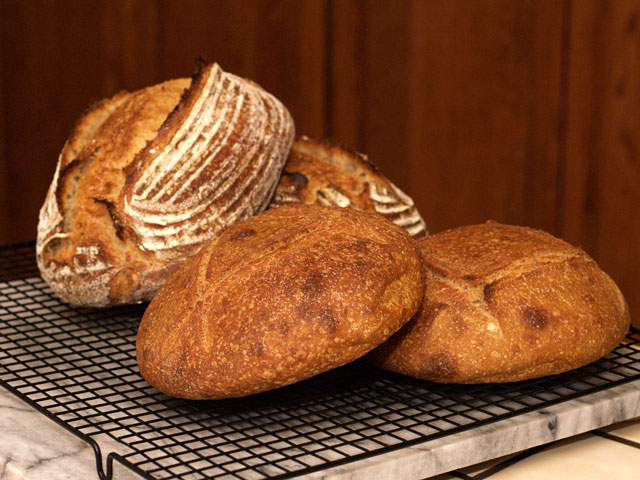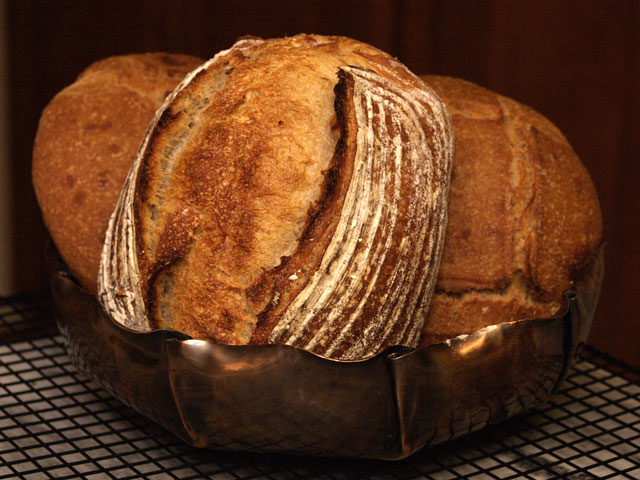
Small Miches, Pointe-à-Callière and Straight Sourdough 70% Hydration
Inspired by Shiao-Ping's Miche, Pointe-à-Callière from mid-January, and by the excellent efforts of other bakers here, I decided to try my own hand at this loaf. My wife requested some loaves for her sister's birthday coming up soon, and it seemed a good opportunity to try this. I have never had Hamelman's book in hand, and have not baked this loaf before, so I followed Shiao-Ping's excellent instructions for this bake. My only departures were to blend my own flours from home-milled hard red ww and hard white ww plus KA AP flours, to extend the bulk fermentation to about 14 hours due to limitations of life, and to bake the dough as two smaller loaves, which resulted in much shortened baking times, so we could keep one at home to try for ourselves. I was reassured to find my impressions of the dough development to be almost exactly in parallel with Shiao-Ping's observations from her blog post referenced above.
At the same time, in need of more gift loaves, I continued to push my exploration of higher hydrations in my own straight sourdough formula, with this bake done at 70% hydration. The resulting loaves had amazing oven spring, and the flavor is just excellent. The crumb is tender and creamy, and has a very distinct but subtle flavor. This dough was also bulk fermented in the refrigerator for about 14 hours alongside the Pointe-à-Callière. This resulted in very good flavor, but not a strong sour. The higher hydration had me worried during the development of the dough, but after the bulk fermentation the dough had come together almost startlingly firmly. Formation and proofing resulted in loaves with very good integrity despite being the highest hydration dough I have made thus far in this exploration.
Here are the loaves together.

and a better look at the Pointe-à-Callière

Here is the straight sourdough

I must admit I am quite pleased with the results of both of these breads. The miches had wonderful spring in the oven compared to my previous attempts at a whole wheat loaf, and the sourdough was also a very good performer on that score. I wish I had pictures of the miche loaves before baking because they looked almost dead to me. I was not only pleased but quite surprised at the spring and life in them in the oven. They taught me a great deal about judging dough for future reference.
The crumbs of both are also quite nice. I succeeded in getting much better gelatinization in the crumb of both loaves in this bake than I have accomplished previously. Now, if I can just zero in on the factors that led to it! I am focusing on the high hydration levels as the primary contributors at the moment, together with the La Cloche baker. I baked all of these loaves one-by-one en cloche. I also extended the time under cover to 20 minutes, and left the oven at the full 500F temperature for the full 20 minutes. I lowered the temperature to 460F just before opening the oven to uncover each loaf.
Here are crumb shots of each, beginning with the Pointe-à-Callière.

and the sourdough looks like this

While I am feeling pretty proud of these loaves, and especially of the Pointe-à-Callière, I am not sure if this is the way the loaf is "supposed to" come out. For one thing, I wish I had floured the loaf a bit prior to baking. As it is, it finished with that "wet sandstone" finish I find very typical of my past high hydration whole wheat efforts. I have seen the same thing in pan loaves I have baked, and I don't find it very attractive. Shiao Ping's presentation is much more winsome! Also, the flavor is pretty mild, and I was expecting a much sharper sour flavor after the long cold bulk fermentation, similar to other Hamelman loaves I've tried. Could this just be the nature of my starter? I don't object, but it was not quite what I thought was expected here.
Thank you for reading this far! Happy Baking
OldWoodenSpoon


Comments
I believe those loaves are perfect! The crust is beckoning a good chewing and the color is beautiful to look upon. Congrats on baking such nice loaves.
When it comes to the flavor, I can not give you any advice unfortunately. When I bake the same miche my flavor is a bit sharp but I can definetly taste the whole wheat more than my starter, which I am fine with.
Are you saying you looking for a sharper tang, or a more pronounced flavor from the starter? If from the starter, maybe try refreshing the firm starter a few times over again before using it in the dough. Or let the dough rise in a cold place for a longer fermentation, this will help bring along the tang you might be looking for.
This is just coming from me though, hopefully someone with more knowledge will be able to send some answers your way.
Though I still think those loaves are wonderful!
Beautiful loaves!!!!
Sooo good and tempting!!!
Salma
LeeYong, Salma: Thank you!
Arlo: I'm really saying I don't have experience with this whole wheat formula, and so don't know what it should taste like. I know it will vary, but Hamelman had something in mind when he developed this formula. I just don't know how close to that I came. I don't "blame" my starter though, because while it is fairly mild it has produced some pretty sharply sour loaves in the past with this long a bulk fermentation. I was somewhat surprised to find this loaf not so very sour.
I too taste the wheat more than the sour, and I welcome that for my personal taste. I also like, however, that the wheaty flavor is not so sharp as loaves I have baked from 100% hard red winter wheat. The red wheat has a strong tang that I don't care for so much at full strength. This blend toned that down pretty well, and I like the flavor I got as a result.
Thank you
OldWoodenSpoon
If you want a miche with more sour try the Mixed flour miche in Hamelman's book. And, try proofing it overnight or at least a little longer than you're supposed to in a cold place. Mine was very tangy. The second time I made it without the overnight proof it was still tangy but not nearly as much.
I think the rye/whole wheat combination starters might be the key to the added tanginess in this miche. He even warns not to overnight proof this particular loaf. (I only did out of time constraint the first time. So, you could probably make it and find just the right amount of cold proofing to pull out the tanginess of flavor.
What bannetons are you using to get your beautiful little loaves? I need to get some of those. They are lovely!
Tracy
are the 1 Lb oval willow ones from SFBI (TMB Baking). I live close enough that we just drove over there one day during Christmas week. You can also get them other places, like www.fantes.com. The fantes.com site has an excellent selection, whereas TMB Baking only carries the few they use in classes. Their store is, they say, mostly an accommodation of their students, so they can obtain the same tools they use in class to use at home.
We love the loaves that come out of these nice little baskets. They are a perfect size for us, and it is a good batch size for baking in my kitchen. I also bought two 1.5 Lb round bannetons at the same time, but have only used them once or twice. The miches in this bake were proofed free-form (isn't that required in order to call it a miche?).
One day I hope the library will get Hamelman's books in. So far my public libarary does not have any of them, although they have a good many by other authors. I would like to read his thoughts on baking, and especially on sourdough. It seems from the bits and pieces I have picked up that his sourdough recipes frequently have a strong sour, by reputation at least if not in fact. I'd like to read how he puts them together.
Thanks for the kind words Tracy. I read your posts often, and it sounds like you are getting along pretty well now in your temporary RV digs. Thanks for stopping by.
OldWoodenSpoon